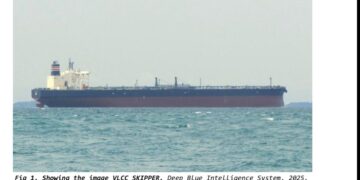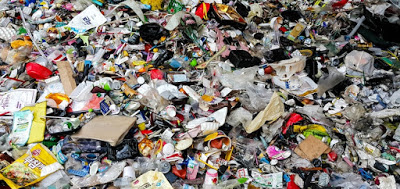There’s no doubt the great future of plastics from “The Graduate” came to fruition. Landfills are overflowing with plastics, with more than 8 million tons of plastic dumped into oceans annually, according to Plastic Oceans International.
Packaging makes up more than 40% of the world’s total plastic usage, yet less than 14% of plastic packaging is recycled globally, according to the Ellen MacArthur Foundation. The low rate is due to a variety of reasons, including consumers lacking awareness of where and how to recycle, and a weak collection and processing infrastructure.
Many large retailers and manufacturers are ramping up their sustainability efforts by decreasing plastic use for packaging or ensuring the plastic is at least recyclable and recycled.
This doesn’t necessarily mean eliminating plastic in their supply chains.
“We don’t see a world without plastic. We focus on a world without packaging waste in our lands and oceans,” Laura Rowell, global sustainability manager of consumer packaging at Sonoco Products, told Supply Chain Dive. Sonoco manufactures consumer goods packaging, including paper, plastic and film.
Walmart announced its latest plans in February, to target its private brand packaging to reduce plastic waste, affecting more than 30,000 SKUs in the retailer’s inventory.
Trader Joe’s announced in December it would reduce plastic packaging in stores, even while noting “most of the plastic in our packaging has the highest recyclability acceptance
rate in the U.S.”
rate in the U.S.”
How to set goals for plastic reduction
More than 250 companies signed on to the goals set forth by the New Plastics Economy vision from the Ellen MacArthur Foundation, which promotes eliminating unnecessary and
problematic plastic use, innovating plastic materials so they can be reused and recycled and keeping plastic out of the environment.
problematic plastic use, innovating plastic materials so they can be reused and recycled and keeping plastic out of the environment.
One goal is to make plastic packaging 100% recyclable or compostable by 2025. The companies who signed on represent 20% of the plastic packaging produced globally, including Coca Cola, PepsiCo, Danone and Unilever.
Walmart encourages all suppliers to set goals and follow the steps in its sustainable packaging playbook, where it provides guidance and best practices on designing recyclable packaging.
Before Sonoco created goals to reduce or eliminate wasted plastic, the company first looked at its current practices. “Recycling and use of recycled material are significant means of reducing wasted plastic,” Rowell said.
It currently uses 22% recycled plastic in its manufacturing operations, and 19% of that is post-consumer plastic.
Sonoco deliberated how to improve that figure, considering a significant percentage of
its packaging has direct food contact. The company created options for the R&D team to pursue. One tact was to improve the recyclability and collection of thermoform produce packaging.
its packaging has direct food contact. The company created options for the R&D team to pursue. One tact was to improve the recyclability and collection of thermoform produce packaging.
Trader Joe’s is evaluating its packaging through its sustainability framework, which includes reducing and removing packaging; sourcing renewable and recycled packaging materials; choosing packaging that can be realistically recycled; and avoiding the use of harmful substances in packaging.
Trader Joe’s stopped offering customers single-use plastic carryout bags and replaced plastic produce bags with biodegradable and compostable bags for its loose fruits and vegetables.
The grocer is decreasing the number of produce items sold in plastic bags and replacing Styrofoam trays holding fresh meat with recyclable PET trays.
The company is also eliminating the non-recyclable plastic pouches from its tea packages and replacing the flower bags with a “renewable material.”
Consider the product, the package — and even the label
When talking with customers about how to design their packaging, manufacturers have
to consider the product. “Consumers don’t buy a cereal box. They buy the cereal,” Rowell said. Sonoco asks customers what they are packaging and their goals and then presents the options.
to consider the product. “Consumers don’t buy a cereal box. They buy the cereal,” Rowell said. Sonoco asks customers what they are packaging and their goals and then presents the options.
Reducing wasted plastic is part of the sustainability framework, but it’s important to maintain product integrity and prevent food waste.
Walmart identifies the most common types of packaging for its private label brands and considers what’s feasible in terms of potential recycled content and what their competitors are doing, Ashley C. Hall, senior manager of sustainability at Walmart, told Supply Chain Dive.
That sometimes means stepping back to consider the packaging without the product in it. PET bottles aren’t just used for water, juice and soda, but can be used with pumpable soap, cleaning spray and mouthwash.
“There can be very small design changes,” Hall said, like eliminating a plastic window in a package, which won’t affect sales but will reduce plastic use. Companies should also ask packaging suppliers how much recycled content they’re already using, as they may not realize they already are using some.
Walmart’s playbook shares ideas on packaging changes that can reduce plastic use, like removing shrink-wrap sleeves from PET bottles, as the shrink-wrap isn’t recyclable, rendering the PET bottles not recyclable. The playbook suggests removing metal, PVC and other materials that make an otherwise recyclable bottle ineligible.
To maximize effective recycling, even the packaging labels should be evaluated. Sonoco
works with customers to improve the package labeling to bring them in line with Association of Plastic Recyclers (APR)-recognized inks, labels and adhesives — ones that have been proven to not contaminate the PET recycling stream.
works with customers to improve the package labeling to bring them in line with Association of Plastic Recyclers (APR)-recognized inks, labels and adhesives — ones that have been proven to not contaminate the PET recycling stream.
The label ink can discolor the plastic during recycling, affecting how people perceive the plastic used in packaging food, said Rowell. The APR has label protocols, and companies can ask the label supplier if they’ve been recognized as such.
A different kind of plastic
Plastics come from fossil fuels, and a growing number come from agricultural products,
like sugar beets and corn.
like sugar beets and corn.
Swapping conventional plastics for bio-based plastics may seem like a sustainable move.
However, not all bio-plastics can be recycled in the traditional recycling stream, as they cause problems at recycling centers due to different melting temperatures.
Rowell said her company is not fond of degradable plastics, as composters are reluctant to
take any plastic to their composting streams, and Sonoco doesn’t want to mislead consumers into thinking they are recycling, when the items end up in the dump.
take any plastic to their composting streams, and Sonoco doesn’t want to mislead consumers into thinking they are recycling, when the items end up in the dump.
“It doesn’t work for us to say it’s compostable if we know for a fact it won’t get composted.”
Many corporate efforts revolve around decreasing single-use plastic items made from
virgin plastic, which has not been recycled.
virgin plastic, which has not been recycled.
Recycled plastic tends to be more expensive than virgin plastic, said Rowell, as the recycled
material has to be collected, processed and sanitized for safe use. That said, there’s an increased commitment by many brands to use recycled plastic, regardless of the higher costs.
material has to be collected, processed and sanitized for safe use. That said, there’s an increased commitment by many brands to use recycled plastic, regardless of the higher costs.
Contrast that with infrastructure improvements to remove wasted plastic from the
environment, and there’s a big difference. “Remember that most developing countries are not blessed with recycling systems, waste-to-energy facilities and landfills. Much of their waste goes into the environment,” Rowell said.
environment, and there’s a big difference. “Remember that most developing countries are not blessed with recycling systems, waste-to-energy facilities and landfills. Much of their waste goes into the environment,” Rowell said.
Plastic substitutes: It’s not as simple as good or bad
Packaging material substitutions are sometimes possible, but all materials have environmental issues, said Rowell. “It’s not that plastic is bad and everything else is good,” she said.
Materials like glass, paper, steel and aluminum for consumer products are heavy and must be balanced with other needs. “We can turn everything that uses flexible film into
paperboard, but it uses a lot more fiber and it’s a lot heavier,” she said.
paperboard, but it uses a lot more fiber and it’s a lot heavier,” she said.
Paper can be from recycled fibers or from forests. “In a world without plastic, in five years we’re talking deforestation,” said Rowell. Even if collecting and using a significant amount of recycled paper, that paper can’t supply the world’s needs, she said. And not all countries can grow their own fiber.
Glass is a great material as well, Rowell said, but “you don’t want glass shampoo bottles.”
Plastic use does not need to be eliminated to help the environment. It offers value and decreases food waste. “Studies show that the shelf life of fresh produce can be significantly lengthened by the use of minimal plastic film protection,” said Rowell.
Food production is energy, land and water dependent, so eliminating or decreasing plastic use must be weighed against those resources. Methane from rotting food can impact the climate as well, said Rowell, and plastic use can help decrease that food waste.
“I’ve never seen a perfect environmental package,” Rowell said. “By living, we impact the environment.” The goal is to impact the environment the least amount possible.
Supply Chain Dive.
































































